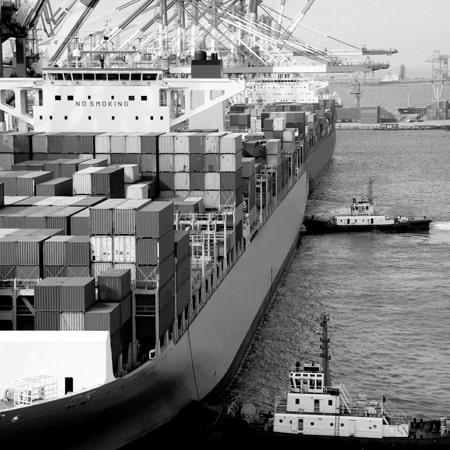Combined transport by sea
Combined transport is the transport of the same goods by two or more different modes of transport without changing the transport packaging. Combined transport reduces transport costs and helps to make the supply chain of goods or raw materials more efficient, extending the possibilities of door-to-door delivery. Combined transport is inevitable in air and sea transport and has long been used for the delivery of goods from the airport or to the seaport by road. However, it was only a few decades ago that logistics professionals identified combined transport as a distinct mode of transport.
The most significant influence on the popularity of combined transport has been the containerisation process. The standardisation of maritime containers has made it much easier to adapt other modes of transport to land transport of containers, which is why combined transport has become particularly widespread in maritime transport. The delivery time of goods transported by ship increases, but the long distances covered by sea reduce transport costs. When goods are delivered to seaports by ship, they are transhipped and delivered to the consignee’s door by road or rail. Today, this is an integral part of maritime transport, as only in very few cases does the delivery end at a seaport. The separation of sea and combined transport of containers has opened up additional opportunities for tailor-made solutions reducing the sea route and transport time. The delivery process goes as follows: bulk of the delivery route by sea, followed by land delivery by rail, and only the last part of the route by road to reduce transport costs. Combined transport thus gives each customer the opportunity to choose the transport that best suits their needs.
The most commonly used variants of combined transport by sea are:
Transportation of cargo in full sea containers from ports all over the world to the port of Klaipėda by ship and further delivery to the consignee by train:
– The ‘Amber Train’ connects Šeštokai railway station with the Estonian port of Muuga. These are train routes designed to provide an alternative to container delivery by sea. Cargo to/from Šeštokai railway station reaches its final destination on a narrower, European rail track, so the routes stretch across Europe.
– The Vilnius Shuttle and Vilnius Express run between Klaipėda – Vilnius – Klaipėda. These are train routes for container deliveries within Lithuania. The daily trains deliver containers from Klaipėda Draugystės station to Vilnius Intermodal Freight Station.
– Container trains from China are trains that transport goods to/from various railway stations in China and reach Europe within two to three weeks. This route transports large volumes of containers, but individual container or part-load shipments are also possible.
Transportation of cargo in full sea containers from ports around the world to Klaipėda or Western European ports by ship and onward delivery to the consignee by road:
In most cases, when combining different modes of transport, the aim is to leave as little of the route as possible to road transport, due to its uneconomic nature and slower border crossing procedures. However, due to its manoeuvrability and ability to deliver cargo to the door at any location, the seaborne cargo shipped in seaports is usually continued to the destination by road transport. The most popular delivery routes for goods arriving at ports in full containers are:
– Port of Klaipėda – Lithuanian and Latvian cities
– Port of Riga – Latvia, Lithuania, Estonia
– Port of Tallinn – Estonia
– German ports of Bremerhaven, Hamburg, Cuxhaven, Bremen – Lithuania
– Belgium Antwerp Port – Lithuania
– Port of Rotterdam in the Netherlands – Lithuania
– Lithuania – Dutch, Belgian, Italian ports
Transport of partial sea containers by combined transport:
Due to the low export volumes of Lithuania and the Baltic States, all cargo transported in partial sea containers is transported by road to major Western European seaports and consolidated there. This transport is a good example of the advantages of combined transport, as without the possibility to deliver the cargo to the major European consolidation points by road, the consolidation of the partial sea containers would take up to 10 days longer.
Combined transport is unavoidable in door-to-door delivery and its potential is not fully exploited today. Lithuanian and foreign customers are only now discovering the new possibilities of combining road, rail and sea transport for the delivery of goods in Europe, which is actively supported by the European Union.
– Full Container Sea Freight (FCL)
– Sea freight transport in partial containers (LCL)
– Sea freight delivery by container trains.
Questions? Contact us by email info.lt@a2cargo.com, info.lv@a2cargo.com or
call +370 5 215 13 52, +371 67 383655.
Do you want to get a quote? Fill in the form.

